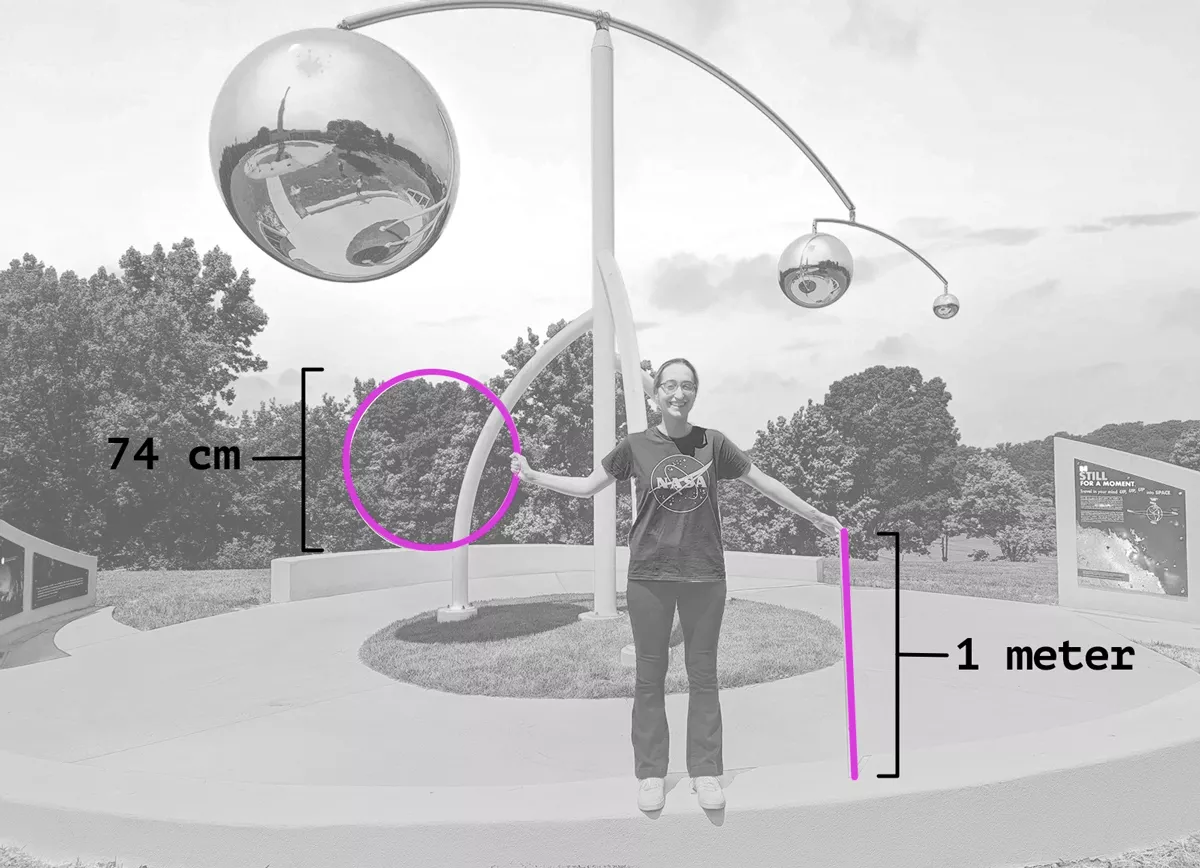Learn more about JPSS and GOES’ sculpture at the NASA Goddard Visitor Center with a challenging fermi problem. Fermi problems, named after physicist Enrico Fermi, are open-ended problems where students have to make assumptions, estimates, and educated guesses to creatively solve a problem. These complicated problem-solving exercises help students gain confidence in thinking like an engineer or scientist. These questions can be a fun way to encourage students to work on math problems as a group and can be tailored to a variety age levels.
The FERMI question: How much does the largest stainless-steel sphere on Orbits Interweave weigh in kilograms?

Lesson Plan
The scientists and engineers who work on the Joint Polar Satellite System (JPSS) use creativity, research, data collection, math, and the scientific method to solve complex problems with many variables.
Fermi Problems
Fermi problems, named after physicist Enrico Fermi, are open-ended problems where students have to make assumptions, estimates, and educated guesses to creatively solve a problem. These complicated problem-solving exercises help students gain confidence in thinking like an engineer or scientist. These questions can be a fun way to encourage students to work on math problems as a group and can be tailored to a variety age levels.
Fermi problems all involve:
- A challenging open ended problem
- Many variables
- Creative solutions
- Estimates
- Research
Some examples:
How many pine trees can fit your classroom? How much water, in liters, is in the ocean? How long would it take to make a hundred pitchers of lemonade?
Customizing Fermi Problems
Fermi problems can be tailored to be more or less difficult in order to suit a variety of mathematical skill levels. More information can be given including relevant facts, similar statistics, and equations to make the problem easier to solve. Information can be withheld, use of tools like the internet or calculators can be restricted, or time limits can be set to make problems more of a challenge. A good Fermi problem is somewhat solvable within a range of answers even if a concrete answer is not known. Make sure to choose questions that have answers within a range you can confirm. The process of solving the problem can be more rewarding than a correct answer so be sure to communicate this expectation to the participants, so they don’t get frustrated.
Using This Activity
Only print and distribute the second page of this document. Introduce the concept of Fermi problems and emphasize that these problems are intended to be challenging and require creativity, problem solving, and brainstorming. Encourage students to make sketches and take measurements of other available items that might help them come up with better results. Group work is highly recommended. After the students have had time to come to conclusions collect the answers, compare, and discuss. Are the conclusions similar? Are any of the answers very different? How did each group arrive at their results? What assumptions were made? Where do they think they might have errors? Where do they feel confident? After discussing the process and hearing how others attacked the problem work as a group to solve the problem together and see if you can improve your results.
Orbits Interweave Problem
Helpful tools:
- Gridded paper
- Meter sticks
- Measuring tape
- String
- Google Earth Imagery
- Calculator
Located on the outer edge of the Rocket Garden at the NASA Goddard Visitor Center, Orbits Interweave, an exhibit by the Joint Polar Satellite System (JPSS) program and the Geostationary Operational Environmental Satellite - R (GOES-R) Series program features an abstract kinetic sculpture highlighted by three polished stainless-steel spheres. Reflecting the world back to anyone looking at them, the spheres move gently in response to the wind and can be loosely interpreted to represent the Sun, Earth, and the satellites. JPSS and GOES-R are part of a collaboration between NOAA and NASA. This outdoor exhibit is open to the public to educate about these missions' roles in weather forecasting and how they help us in our everyday lives.
How much does the largest stainless-steel sphere on Orbits Interweave weigh in kilograms?
Use the clues in the image below to help you make your best guess.

Answers and Helpful Hints
If the participants are struggling with how to solve the question, you can help them by giving them equations and encouraging them to make estimates for the variables. Or you can give them additional information.
For example: The spheres are made out of 2 mm stainless sheet steel which weighs 16 kg/m2.
Mass = (4/3) × π × radius3 × density
The sculpture can be found on map imagery at: 38°59'35.1"N 76°50'51.7"W
The actual weight of the spheres can be found at: https://youtu.be/BYhIfZQcNk0
Other JPSS Inspired Fermi Problems
- How heavy is JPSS?
- How large a cylinder will the JPSS spacecraft fit into?
- How many basketballs put in a line would be needed to reach from Earth to JPSS?
- How many gallons of paint would it take to paint JPSS purple?
- How many candles would you need to have on a birthday cake to be seen by VIIRS?
- If you stacked JPSS satellites, how many would you need to reach the moon?
- How many pizzas would have to be in a hurricane for them to be visible in JPSS imagery?